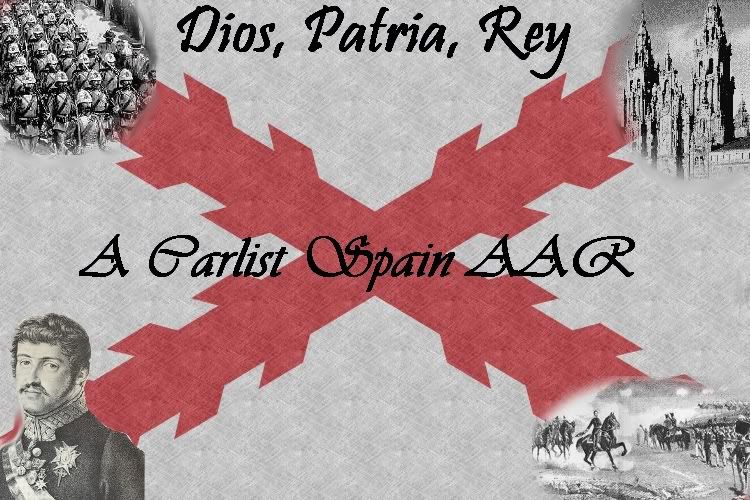Dios, Patria, Rey - A Carlist Spain AAR
- Thread starter Tommy4ever
- Start date
-
We have updated our Community Code of Conduct. Please read through the new rules for the forum that are an integral part of Paradox Interactive’s User Agreement.
You are using an out of date browser. It may not display this or other websites correctly.
You should upgrade or use an alternative browser.
You should upgrade or use an alternative browser.
- Status
- Not open for further replies.
From the WritAAR who brought you the likes of Austriae est imperare orbi universo - a Habsburg AAR and Defenders of Freedom and Democracy - A Democratic German AAR comes Dios, Patria, Rey - A Carlist Spain AAR. 
The title means God, Fatherland, King in Spanish, which I have been led to believe was the slogan of the Carlists. As the AAR title suggests I shall be playing as everybody's favourite absolutionists - the Carlists.
In game terms I moved all my armies into the far South and lef the Carlist rebels to take Madrid, in mid 1848 the rebels secured victory and I became an absolute Monarchy with the beautiful Cross of Burgundy as my flag.
I'd like to thank HMAS-Nameless the author of Gott Mit Uns! - Rise of the Black Eagle who helped me make the pretty looking picture in the above post.
The first proper update will likely be up tomorrow. It shall detail how we got to the position we are in as of 1838 and will therefore look at post Napoleonic Spain up to and including the Carlist War (or Carlist Revolution if you like).
Almost forgot to post this. I'm playing 1.1 with one slight modification - I'm using Gongj's rebel tweak which weakens the rebels who I think we can all agree are rather silly at the moment.
The title means God, Fatherland, King in Spanish, which I have been led to believe was the slogan of the Carlists. As the AAR title suggests I shall be playing as everybody's favourite absolutionists - the Carlists.
In game terms I moved all my armies into the far South and lef the Carlist rebels to take Madrid, in mid 1848 the rebels secured victory and I became an absolute Monarchy with the beautiful Cross of Burgundy as my flag.
I'd like to thank HMAS-Nameless the author of Gott Mit Uns! - Rise of the Black Eagle who helped me make the pretty looking picture in the above post.
The first proper update will likely be up tomorrow. It shall detail how we got to the position we are in as of 1838 and will therefore look at post Napoleonic Spain up to and including the Carlist War (or Carlist Revolution if you like).
Almost forgot to post this. I'm playing 1.1 with one slight modification - I'm using Gongj's rebel tweak which weakens the rebels who I think we can all agree are rather silly at the moment.
Last edited:
nice to see the aar up and running. Ill make a post advertising your aar in mine for the honor I have in your second post
Spain 1812-1833
Spain’s history during the 19th century is a tale of the battle between liberalism and conservatism and the desperate struggle of successive regimes to find a balance between Spain’s two ideological poles.
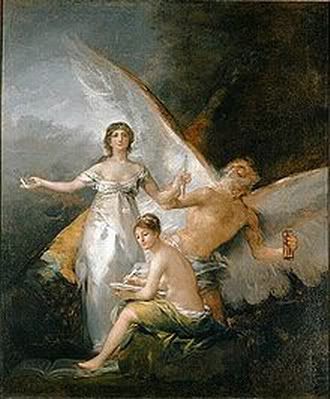
In 1812, whilst still in exile due to the French occupation of Spain, the Spanish government issued the nation’s first constitution. This highly liberal constitution promised, amongst other things, universal suffrage, constitutional Monarchy, freedom of the press, freedom of enterprise and sweeping land reforms. The constitution was regarded as a beacon of liberalism in Europe and was seen as the liberal ideal.
[
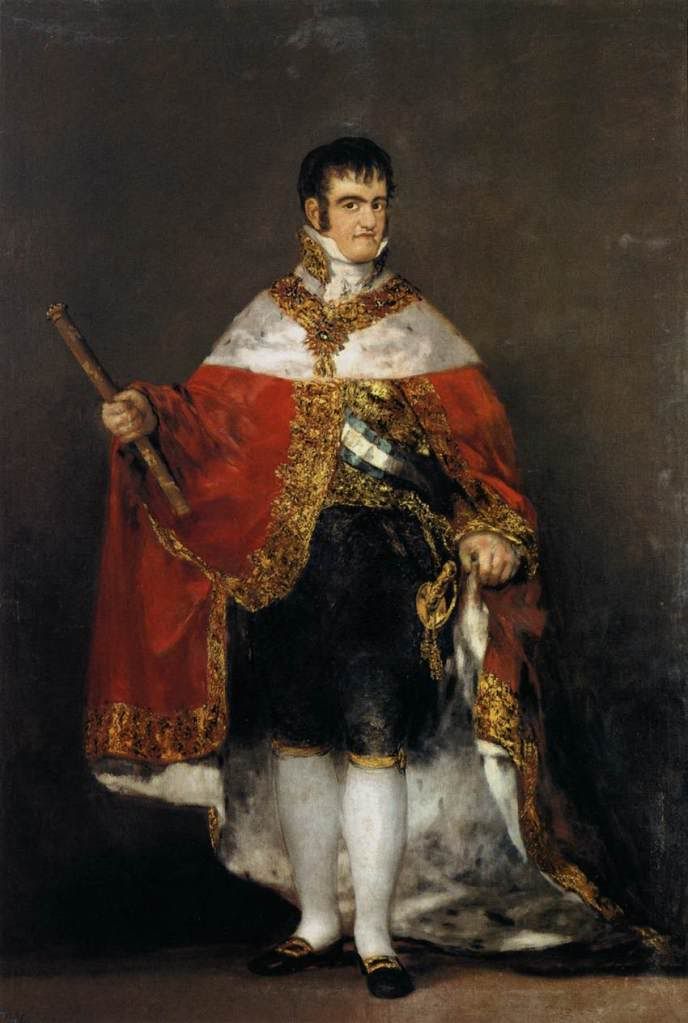
However for Spain’s liberals it was destined not to be. Following his restoration to the Spanish throne on December 11th 1813 and the final defeat of the French in Spain Ferdinand reneged upon his promises to the liberals that he would uphold the Constitution and instead restored a reactionary absolutist state due to the urgings of his conservative supporters.

Spain had regained her independence and Ferdinand returned to become the head of a mighty Empire second only to that of the British. However this great mass of land was of little use to Spain, the disruption of trade with the Empire and the costs of war had left Spain bankrupt whilst in America the Empire was already falling apart. In reality Spain’s rule was already limited on the mainland to Peru, Mexico and Central America as junta had formed in New Granada, Chile and La Plata. Ferdinand’s desperation to reclaim these lost colonies would ultimately lead to the collapse of the entire Spanish Empire in the Americas.

The Spanish were initially very successful as in 1814 Chile was restored to Spain and the following year Simon Bolivar (the top Generalissimo in Northern South America) was forced into exile to Haiti. However it did not take long for things to turn back against the Spanish crown. In 1816 Bolivar returned to New Granada with significant popular support and the aid of Haitian weapons and troops. The on February 12th 1817 defeat at the Battle of Chacabuco sealed Chilean independence for good. On August 7th 1819 Colombia and Venezuela were able to permanently break free following the decisive Spanish defeat at the Battle of Boyaca. By 1820 Spain still ruled over Ecuador, Peru, Central America and Mexico however Ferdinand remained desperate to reclaim the lost colonies.
Ferdinand hoped to finally resolve the problem in the Americas through a massive injection of troops. In 1820 a large scale expedition was built up in the port of Cadiz that was to finally restore Spanish rule. However the upper echelons of the Spanish Army were heavily liberal, they still felt betrayed by the King’s refusal to enact the 1812 Constitution and were frustrated at the failure of the Spanish economy and the troubles in Spanish society. The liberal officers in the Cadiz expedition seized control of the army and led it across Andalusia hoping to gain support for a revolution, this support would be extremely forthcoming as soon Spanish garrisons across the country began to rise in support of the cause. Hoping to avoid an outright revolution Ferdinand bowed to the wished of the liberals and allowed the Progresista (the liberal faction of government) to seize power whilst the 1812 Constitution was reinstated.
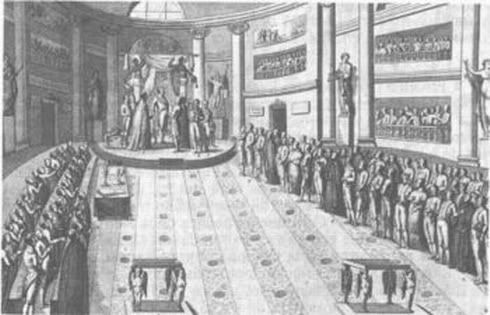
The next three years would be known as the Liberal Trienium and would quickly bring about an anti-liberal backlash. Government attempts to centralise the state encouraged strong opposition from Aragon, Navarre and Catalonia (areas that had long benefited from local decentralised rule) whilst the anti-clerical policies of the government put the Catholic Church against them. The North-East quickly began to flare up in rebellion whilst the situation in the colonies worsened.
The passive disinterest of the liberals in American affairs greatly sped up the decolonisation process in the Western hemisphere. Indeed many in government believed the Empire to be a relic of the past and had no interest in laying down more Spanish lives for its defensive. The liberal leanings of the government convinced Mexico’s conservatives to declare independence. Following the capture of Mexico City by these conservatives in September 1821 Spain recognised the ex-colonies’ independence and the First Mexican Empire was born. That same month Spain relinquished control of Central America, leaving only Peru in Spanish hands. In 1822 the Mexican Empire annexed Central America but after the fall of the Empire and proclamation of the First Mexican Republic in 1823 Central America regained its independence as the United States of Central America. In 1821 the people of Lima had invited revolutionaries to enter their city, forcing the last Viceroy to flee his capital. However in Peru Spain would continue to fight to the end.
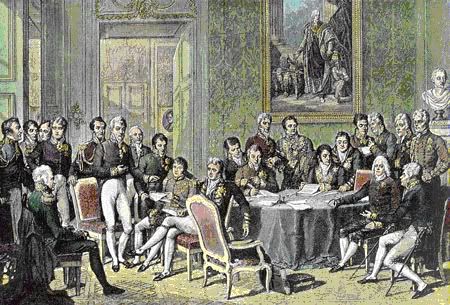
Back in Europe things had worsened for the liberal government as it faced growing opposition at both home and abroad. The slow radicalisation and splintering of the liberals had lost the government the confidence of the military whilst the Royalists had become more intense in their fighting with the government. Meanwhile the nations of Europe had turned against the liberals and on January 22nd 1823 the Congress of Verona gave France a free hand to intervene on the side of the Royalists in Spain.
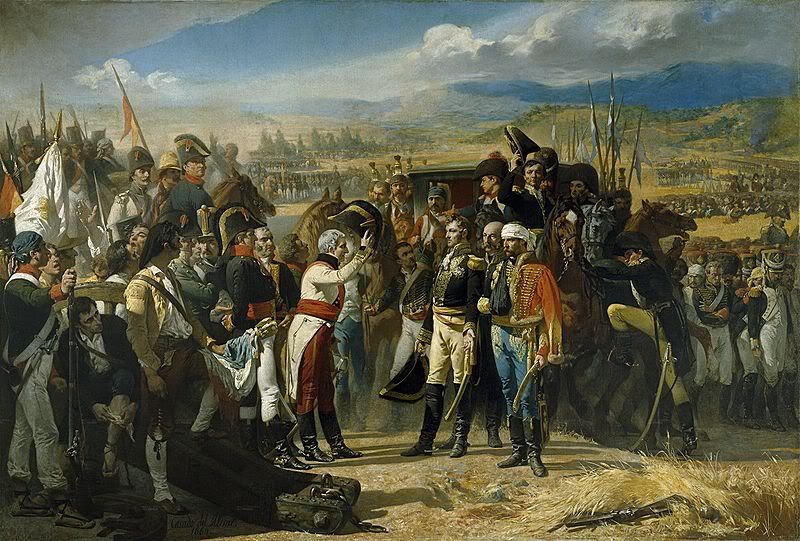
The Bourbon King Louis XVIII formed a huge army known as the ‘Hundred Thousand Sons of Saint Louis’ and invaded Spain in order to restore his fellow Bourbon Monarch, Ferdinand VII, to absolute power. The divided and disorganised Spanish Army barely resisted and the French reached Madrid where they toppled the liberal government and restored Ferdinand to power.
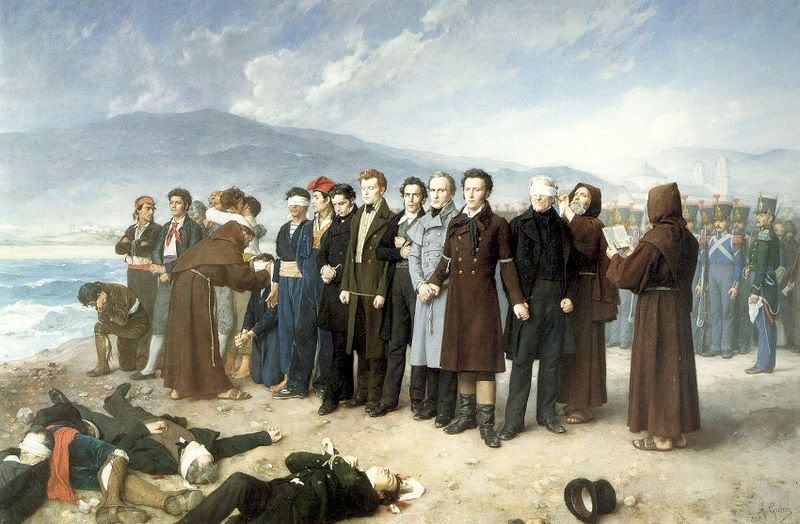
Having been returned to absolute power Ferdinand quickly moved to undo all the liberals had done and to take revenge against those who had left him as a prisoner within his own Kingdom. The 1812 Constitution was repealed, devolved powers returned to the North East and religious institutions restored to politics. Whilst he was forced to grant an amnesty to those involved in the 1820 coup (to do otherwise would mean execution for half the army) Ferdinand did see to the execution of the liberal leader Rafael del Riego amongst other leading liberals.

Ferdinand was still hopeful of restoring the lost American colonies but by this stage they were already lost. At the Battle of Ayacucho on December 9th 1824 the last Royalist army in the Americas was destroyed and Spanish rule forever ended. Unable to muster the resources to launch another expedition and warned against doing so by the British and the USA Ferdinand was forced to abandon the lost colonies.
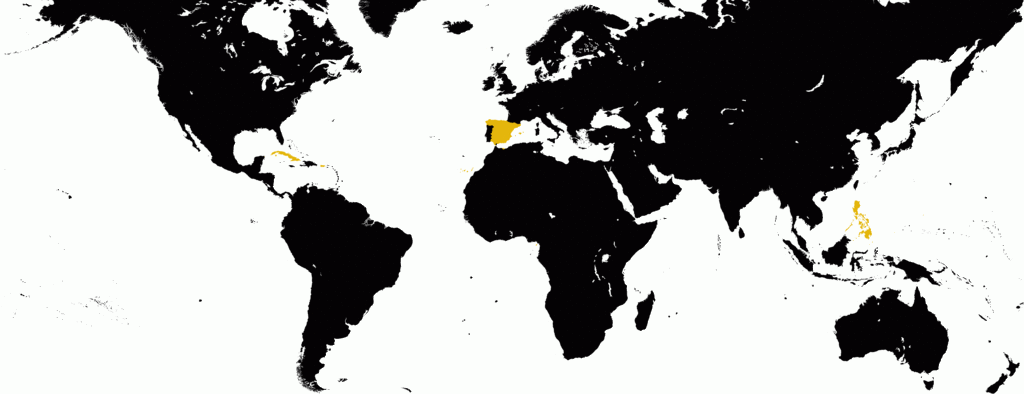
For the next years of his reign Ferdinand attempted to stabilised Spanish politics and almost as importantly Spanish finances (which were by this stage in dire straits). He was forced to accept rule over a much reduced Empire.
As Ferdinand advanced in years and ailed in health he began to think of his succession. Spanish succession laws excluded women from the inheritance of the crown. This meant that the rightful successor to Ferdinand remained his brother, Carlos. However on March 29th 1830 Ferdinand issued the Pragmatic Sanction which would allow women to inherit the throne. On October 10th Ferdinand’s first child, Isabella, was born therefore displacing Carlos as the successor to the Spanish throne by the new laws of succession. Ferdinand feared Carlos’ perceived reactionary extremism and did not want him to upset the balance between the conservatives and liberals he had attempted to create.
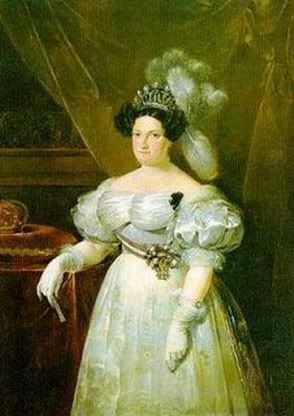 ]
]
Ferdinand came under heavy pressure to repeal the Pragmatic Sanction but a bout of gout left him largely incapacitated and paved the way for his wife Maria Cristina to secure the succession of her daughter. When Ferdinand died in 1833 the babe Isabella was crown Isabella II of Spain with her mother Maria Cristina ruling as regent. Shortly afterwards the Carlist Revolution began as the first guerrillas began to rise up in Aragon, Navarre and Catalonia.
Spain’s history during the 19th century is a tale of the battle between liberalism and conservatism and the desperate struggle of successive regimes to find a balance between Spain’s two ideological poles.

In 1812, whilst still in exile due to the French occupation of Spain, the Spanish government issued the nation’s first constitution. This highly liberal constitution promised, amongst other things, universal suffrage, constitutional Monarchy, freedom of the press, freedom of enterprise and sweeping land reforms. The constitution was regarded as a beacon of liberalism in Europe and was seen as the liberal ideal.
[

However for Spain’s liberals it was destined not to be. Following his restoration to the Spanish throne on December 11th 1813 and the final defeat of the French in Spain Ferdinand reneged upon his promises to the liberals that he would uphold the Constitution and instead restored a reactionary absolutist state due to the urgings of his conservative supporters.

Spain had regained her independence and Ferdinand returned to become the head of a mighty Empire second only to that of the British. However this great mass of land was of little use to Spain, the disruption of trade with the Empire and the costs of war had left Spain bankrupt whilst in America the Empire was already falling apart. In reality Spain’s rule was already limited on the mainland to Peru, Mexico and Central America as junta had formed in New Granada, Chile and La Plata. Ferdinand’s desperation to reclaim these lost colonies would ultimately lead to the collapse of the entire Spanish Empire in the Americas.

The Spanish were initially very successful as in 1814 Chile was restored to Spain and the following year Simon Bolivar (the top Generalissimo in Northern South America) was forced into exile to Haiti. However it did not take long for things to turn back against the Spanish crown. In 1816 Bolivar returned to New Granada with significant popular support and the aid of Haitian weapons and troops. The on February 12th 1817 defeat at the Battle of Chacabuco sealed Chilean independence for good. On August 7th 1819 Colombia and Venezuela were able to permanently break free following the decisive Spanish defeat at the Battle of Boyaca. By 1820 Spain still ruled over Ecuador, Peru, Central America and Mexico however Ferdinand remained desperate to reclaim the lost colonies.
Ferdinand hoped to finally resolve the problem in the Americas through a massive injection of troops. In 1820 a large scale expedition was built up in the port of Cadiz that was to finally restore Spanish rule. However the upper echelons of the Spanish Army were heavily liberal, they still felt betrayed by the King’s refusal to enact the 1812 Constitution and were frustrated at the failure of the Spanish economy and the troubles in Spanish society. The liberal officers in the Cadiz expedition seized control of the army and led it across Andalusia hoping to gain support for a revolution, this support would be extremely forthcoming as soon Spanish garrisons across the country began to rise in support of the cause. Hoping to avoid an outright revolution Ferdinand bowed to the wished of the liberals and allowed the Progresista (the liberal faction of government) to seize power whilst the 1812 Constitution was reinstated.

The next three years would be known as the Liberal Trienium and would quickly bring about an anti-liberal backlash. Government attempts to centralise the state encouraged strong opposition from Aragon, Navarre and Catalonia (areas that had long benefited from local decentralised rule) whilst the anti-clerical policies of the government put the Catholic Church against them. The North-East quickly began to flare up in rebellion whilst the situation in the colonies worsened.
The passive disinterest of the liberals in American affairs greatly sped up the decolonisation process in the Western hemisphere. Indeed many in government believed the Empire to be a relic of the past and had no interest in laying down more Spanish lives for its defensive. The liberal leanings of the government convinced Mexico’s conservatives to declare independence. Following the capture of Mexico City by these conservatives in September 1821 Spain recognised the ex-colonies’ independence and the First Mexican Empire was born. That same month Spain relinquished control of Central America, leaving only Peru in Spanish hands. In 1822 the Mexican Empire annexed Central America but after the fall of the Empire and proclamation of the First Mexican Republic in 1823 Central America regained its independence as the United States of Central America. In 1821 the people of Lima had invited revolutionaries to enter their city, forcing the last Viceroy to flee his capital. However in Peru Spain would continue to fight to the end.

Back in Europe things had worsened for the liberal government as it faced growing opposition at both home and abroad. The slow radicalisation and splintering of the liberals had lost the government the confidence of the military whilst the Royalists had become more intense in their fighting with the government. Meanwhile the nations of Europe had turned against the liberals and on January 22nd 1823 the Congress of Verona gave France a free hand to intervene on the side of the Royalists in Spain.

The Bourbon King Louis XVIII formed a huge army known as the ‘Hundred Thousand Sons of Saint Louis’ and invaded Spain in order to restore his fellow Bourbon Monarch, Ferdinand VII, to absolute power. The divided and disorganised Spanish Army barely resisted and the French reached Madrid where they toppled the liberal government and restored Ferdinand to power.

Having been returned to absolute power Ferdinand quickly moved to undo all the liberals had done and to take revenge against those who had left him as a prisoner within his own Kingdom. The 1812 Constitution was repealed, devolved powers returned to the North East and religious institutions restored to politics. Whilst he was forced to grant an amnesty to those involved in the 1820 coup (to do otherwise would mean execution for half the army) Ferdinand did see to the execution of the liberal leader Rafael del Riego amongst other leading liberals.

Ferdinand was still hopeful of restoring the lost American colonies but by this stage they were already lost. At the Battle of Ayacucho on December 9th 1824 the last Royalist army in the Americas was destroyed and Spanish rule forever ended. Unable to muster the resources to launch another expedition and warned against doing so by the British and the USA Ferdinand was forced to abandon the lost colonies.

For the next years of his reign Ferdinand attempted to stabilised Spanish politics and almost as importantly Spanish finances (which were by this stage in dire straits). He was forced to accept rule over a much reduced Empire.
As Ferdinand advanced in years and ailed in health he began to think of his succession. Spanish succession laws excluded women from the inheritance of the crown. This meant that the rightful successor to Ferdinand remained his brother, Carlos. However on March 29th 1830 Ferdinand issued the Pragmatic Sanction which would allow women to inherit the throne. On October 10th Ferdinand’s first child, Isabella, was born therefore displacing Carlos as the successor to the Spanish throne by the new laws of succession. Ferdinand feared Carlos’ perceived reactionary extremism and did not want him to upset the balance between the conservatives and liberals he had attempted to create.

Ferdinand came under heavy pressure to repeal the Pragmatic Sanction but a bout of gout left him largely incapacitated and paved the way for his wife Maria Cristina to secure the succession of her daughter. When Ferdinand died in 1833 the babe Isabella was crown Isabella II of Spain with her mother Maria Cristina ruling as regent. Shortly afterwards the Carlist Revolution began as the first guerrillas began to rise up in Aragon, Navarre and Catalonia.
Last edited:
Haystack rolls by ....
Sure is quiet around here.
I understand that some people are unable to comment on Victoria 2 AARs at the moment but I still assume that some people must be reading this and abale to comment.
I still plan on atleast doing my next two updates. The first will be about the Carlist Revolution (1830-1838) and the second will be round up of my situation in 1838 just after the Carlists take power in Spain.
After that I shall shift to a weekly update schedule which will leave plenty of time for people to comment. Unless comment pick up from the current rate of 0 I might have to abandon this, I simply have no will to put the effort in to write updates if noone comments. Sorry.
Sure is quiet around here.
I understand that some people are unable to comment on Victoria 2 AARs at the moment but I still assume that some people must be reading this and abale to comment.
I still plan on atleast doing my next two updates. The first will be about the Carlist Revolution (1830-1838) and the second will be round up of my situation in 1838 just after the Carlists take power in Spain.
After that I shall shift to a weekly update schedule which will leave plenty of time for people to comment. Unless comment pick up from the current rate of 0 I might have to abandon this, I simply have no will to put the effort in to write updates if noone comments. Sorry.
Enjoying the updates, I really enjoyed your Austrian AAR, and look forward to rest of this one. Fairly ignorant of Spanish 19th Century history, (bar Sharpe) so informative introductions are fascinating. Where did you get your information?
So your'll hopefully get 1 comment per update, who says asking doesn't work?
So your'll hopefully get 1 comment per update, who says asking doesn't work?
It is surprising that people aren't more active here. Oh well, I suppose people are just too busy playing the game. 
Anyways, nice update. You're doing a good job of showing the events that lead up to the rebellion.
Anyways, nice update. You're doing a good job of showing the events that lead up to the rebellion.
Having now seen that there is an existing readership I'm about to write the second and last prelude update. This one of course about the Carlist Reovlution.
I'm embarassed to admit I simply used Wikipedia o. I, like you, learnt alot about Spain in the making of that update.
o. I, like you, learnt alot about Spain in the making of that update. 
One comment per update will of course be my minimum to continue so you could take the mantle of Enewald who so often prevented my AARs from being abandoned.
I'm glad to see your viewing, although I'd prefer if you dampened down your ninja style and introduced some more Brian Blesses style.
Thanks dinofs. I tried not to write this AAR so early but after I got the idea I just couldn't enjoy other games of V2. I just needed to see how I would do with Carlist Spain and I'm having plently of fun in the actual game.
I shall endeavour to meet your expectations.
Enjoying the updates, I really enjoyed your Austrian AAR, and look forward to rest of this one. Fairly ignorant of Spanish 19th Century history, (bar Sharpe) so informative introductions are fascinating. Where did you get your information?
So your'll hopefully get 1 comment per update, who says asking doesn't work?
I'm embarassed to admit I simply used Wikipedia
One comment per update will of course be my minimum to continue so you could take the mantle of Enewald who so often prevented my AARs from being abandoned.
I'm still here. Just all ninja style.
I'm glad to see your viewing, although I'd prefer if you dampened down your ninja style and introduced some more Brian Blesses style.
It is surprising that people aren't more active here. Oh well, I suppose people are just too busy playing the game.
Anyways, nice update. You're doing a good job of showing the events that lead up to the rebellion.
Thanks dinofs. I tried not to write this AAR so early but after I got the idea I just couldn't enjoy other games of V2. I just needed to see how I would do with Carlist Spain and I'm having plently of fun in the actual game.
Good style, well written. Good luck bringing glory back to Spain.
I shall endeavour to meet your expectations.
The Carlist Revolution
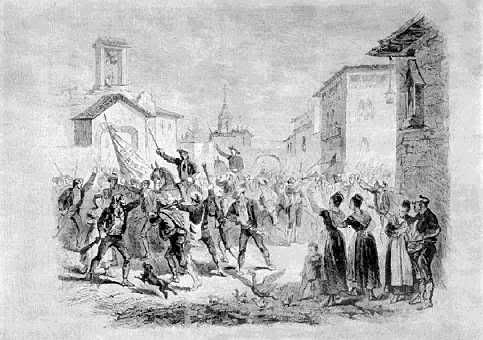
It did not take long for revolts to rise up in the North East following Isabella’s succession in September 1833. The regent Maria Cristina faced strong opposition from regionalists, traditionalists and the church as they were largely in favour of Carlos. This forced Maria Cristina into an unhappy alliance with the liberals which in turn further fuelled anti-Isabella resentment.
However the government acted quickly as the rebels were largely destroyed within a couple of months leaving just a few hundred diehards to survive in the Pyrenees. Carlos himself was sent into exile (travelling first to London and later to Paris where he gained support from the Legitimists). It seemed Carlos’ play for the Spanish crown would be over before it had even begun.

Then on October 29th the Carlist cause found its salvation in the form of Tomás de Zumalacárregui. The Basque General and veteran of the Peninsular had initially been very sympathetic to the Carlist cause but had decided not to join up straight away, believing that the politicians should have a chance to solve the conflict before military men. However the government placed him under house arrest in Pamplona. On October 29th he escaped and soon joined the rag tag band of Carlist militia in the mountains. Within a few months he had transformed this militia into a regular army.
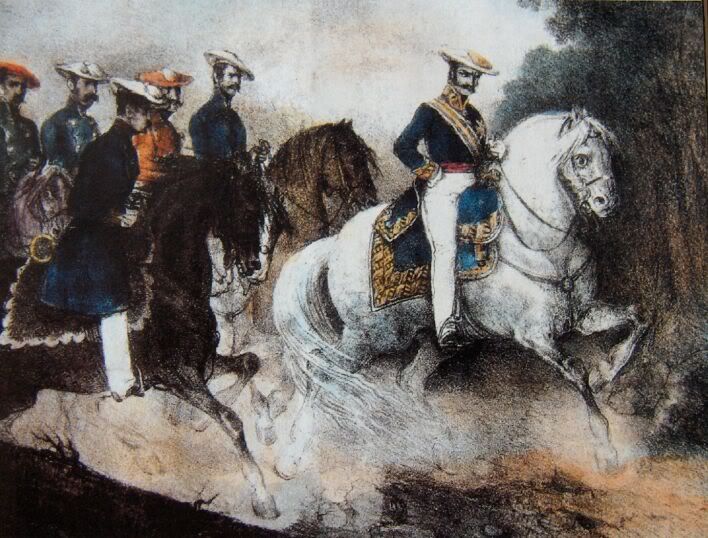
Zumalacárregui proved himself to be as brilliant a commander as he was an organizer. Fighting using guerilla warfare when he could and pitched battles when he had to, time and time again he defeat the government military. By July, when Carlos returned to Spain from France, all of Navarre and the Basque Country outside of several large fortresses and the coastline belonged to the Carlists.
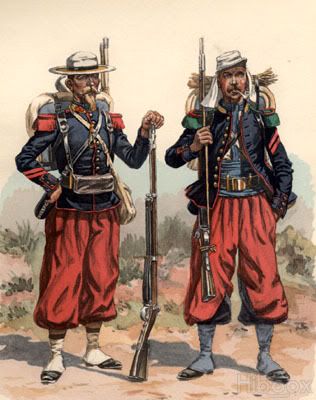
As time wore on the Carlist cause grew in strength as all of Spain North of the Ebro began to fall into the hands of the pretender. This worried the increasingly liberal government’s friends in Britain and France so much that the two powers decided to give significant aid to the government. Loans were granted and guns sold at a cheap price whilst the Royal Navy helped keep the Basque ports in government hands. Both countries also sent troops as the French Foreign Legion and British Auxiliary Legion were dispatched to Spain to help the government. Whilst the government was supported by thousands of foreigners it is estimated that at no point during the Revolution did the Carlist force of foreign volunteers exceed 300.
Over the course of the next year following Carlos’ arrival Zumalacárregui continued to secure greater victories and more territory for the Carlists. However Carlos himself was extremely jealous of his General’s popularity and feared that he may attempt to seize power for himself rather than grant it to the rightful King. Nether the less the uneasy relationship between the two greatest powers of the Carlist movement did not prevent them from securing military success on the field of battle. In April 1835 Zumalacárregui secured his most famous victory as he led a small army of 5,000 men to victory against 22,000 government soldiers at the Battle of Artaza.
By this stage the Carlists could field 30,000 men of a much higher standard than their government counterparts. Yet the Carlists had a key problem – they lacked supplies and money the first of which they had to pillage from the government soldiers and the latter of which they had to rely upon donations for. In the Summer of 1835 Zumalacárregui and Carlos went head to head against each other as they argued over what strategy they should take now that they were in such a strong position.
Zumalacárregui believed that the Carlists should group all their strength together and strike directly at Madrid. However Carlos knew that if this bold move was unsuccessful his rebellion would be over and he favored the more conservative strategy of striking at Bilbao and taking an important port for the Carlists. It was hoped that if this prestigious port was secured the banks of Russia, Prussia and Austria may start to provide loans to the Carlists and their government may start to provide arms. In the end the pretender King won the argument and the Carlists launched an assault on Bilbao – a city protected by the Royal Navy and a substantial government garrison.
The Carlist army brought the port under siege in the Summer of 1835. However on June 14th Zumalacárregui was shot by a musket, he died on the 21st of June leaving the Carlists without their greatest asset. The city fell shortly later but Zumalacárregui had been lost at the worst possible time. On July 16th 24,000 Carlists faced 36,000 government soldiers at the Battle of Medigorria in Navarre.
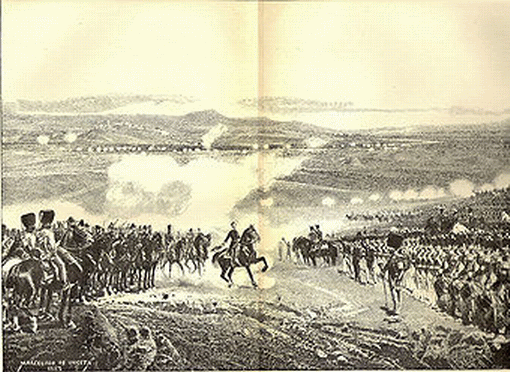
The Battle of Medigorria was the largest engagement of the entire conflict. The Carlists had little wish to do battle against such odds but the liberals had them pinned between their own army and the Arga River. Therefore they risked utter destruction. The fighting was harsh and thousands were killed but the Carlists were able to break through the government lines and reach the Bridge of Larraga allowing them to make their escape. Carlos himself, present at the battle, was almost captured. Despite failing to destroy the Carlist army the government could have easily ended the war following Medigorria but instead they simply settled for containing the Carlists. This allowed the Carlists to regroup themselves and strike again the following year.

The Carlist Revolution was notoriously brutal and both sides frequently killed prisoners of war whilst the government was known for harassing civilians believed to be supporters of the Carlists. After Medigorria the Carlists had entered a stage of the conflict in which they were simply running out of manpower. Around this time they began to give all captured soldiers two choices: join the Carlist army or be executed.
In November 1836 the Carlist launched a brief campaign to try and gain control of Andalusia where they had cultivated significant support. An army was created in the South and soon it looked to threaten government control over the region.

Sadly for the Carlists their ambitions in Andalusia were dashed at the Battle of Majaceite in which a small government cavalry force (70 horsemen) pinned the much larger Carlist army in place until government infantry could arrive to destroy the Carlist army.
With their ambitions in the South coming to naught and their control in the North weakening Carlos realised that unless something drastic and bold was done the war would be lost. So he decided to emulate the idea of his former General, Zumalacárregui, and strike directly at the heart of the government – directly at Madrid. In September 1837 Carlos gathered all the strength he could muster (some 18,000 soldiers) and left his heartland in the North to march on Castile and Madrid. Carlos had hoped to avoid battle and he was indeed able to reach the outskirts of Madrid itself before it became clear that the city would not fall without a pitched battle. On September 24th 1837 the Carlist cause made its last grasp for victory at the Battle of Madrid as 18,000 Carlists faced around 32,000 government soldiers.
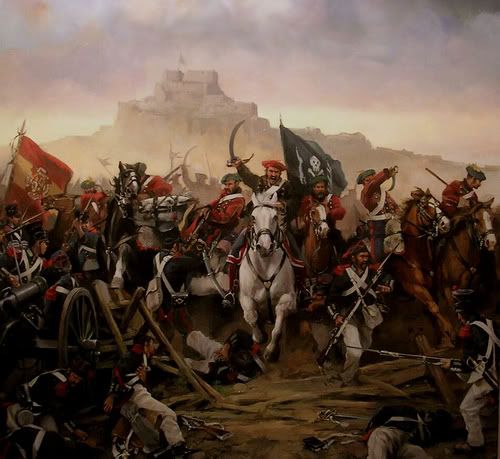
Incredibly the Carlists won. Despite coming under heavy attack from the government artillery and almost breaking in the face of the government’s relentless infantry attacks the Carlist lines held. Then the famed Basque cavalry commander Manu Mariano launched a great cavalry charge that broke the government lines. By the end of the day much of the government army had been captured whilst the rest had either fled or been destroyed. The following day Carlos marched triumphantly into Madrid.
Following the fall of Madrid many regional governors began to recognise the Carlist government in Madrid as the rightful government of Spain. Major victories included Valencia which declared for Carlos in October, Galica which recognised Carlos’ government in the same month and Cuba which accepted Carlist rule in December (becoming the first colony to do so). The liberal government was forced to flee into an ever shrinking pocket in Andalusia which was finally closed when the last liberal fortress fell on February 24th 1838. The Carlist Revolution was over.
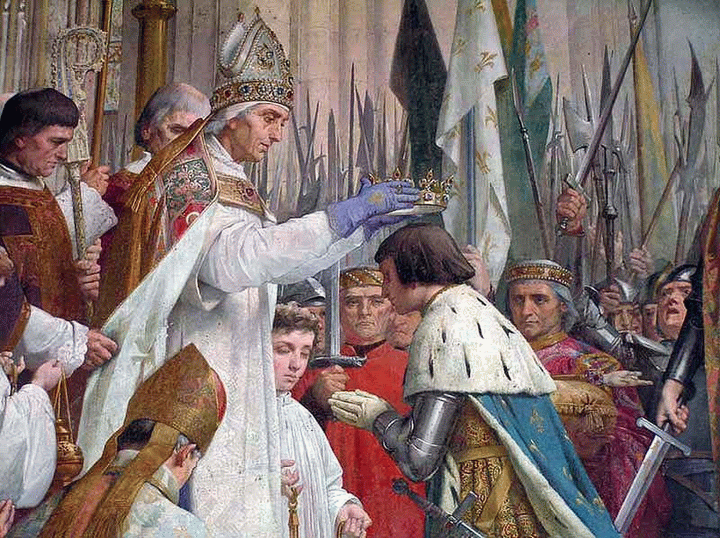
On March 4th 1838 Don Carlos was crowned Carlos V of Spain. The Carlist era had begun.

It did not take long for revolts to rise up in the North East following Isabella’s succession in September 1833. The regent Maria Cristina faced strong opposition from regionalists, traditionalists and the church as they were largely in favour of Carlos. This forced Maria Cristina into an unhappy alliance with the liberals which in turn further fuelled anti-Isabella resentment.
However the government acted quickly as the rebels were largely destroyed within a couple of months leaving just a few hundred diehards to survive in the Pyrenees. Carlos himself was sent into exile (travelling first to London and later to Paris where he gained support from the Legitimists). It seemed Carlos’ play for the Spanish crown would be over before it had even begun.

Then on October 29th the Carlist cause found its salvation in the form of Tomás de Zumalacárregui. The Basque General and veteran of the Peninsular had initially been very sympathetic to the Carlist cause but had decided not to join up straight away, believing that the politicians should have a chance to solve the conflict before military men. However the government placed him under house arrest in Pamplona. On October 29th he escaped and soon joined the rag tag band of Carlist militia in the mountains. Within a few months he had transformed this militia into a regular army.

Zumalacárregui proved himself to be as brilliant a commander as he was an organizer. Fighting using guerilla warfare when he could and pitched battles when he had to, time and time again he defeat the government military. By July, when Carlos returned to Spain from France, all of Navarre and the Basque Country outside of several large fortresses and the coastline belonged to the Carlists.

As time wore on the Carlist cause grew in strength as all of Spain North of the Ebro began to fall into the hands of the pretender. This worried the increasingly liberal government’s friends in Britain and France so much that the two powers decided to give significant aid to the government. Loans were granted and guns sold at a cheap price whilst the Royal Navy helped keep the Basque ports in government hands. Both countries also sent troops as the French Foreign Legion and British Auxiliary Legion were dispatched to Spain to help the government. Whilst the government was supported by thousands of foreigners it is estimated that at no point during the Revolution did the Carlist force of foreign volunteers exceed 300.
Over the course of the next year following Carlos’ arrival Zumalacárregui continued to secure greater victories and more territory for the Carlists. However Carlos himself was extremely jealous of his General’s popularity and feared that he may attempt to seize power for himself rather than grant it to the rightful King. Nether the less the uneasy relationship between the two greatest powers of the Carlist movement did not prevent them from securing military success on the field of battle. In April 1835 Zumalacárregui secured his most famous victory as he led a small army of 5,000 men to victory against 22,000 government soldiers at the Battle of Artaza.
By this stage the Carlists could field 30,000 men of a much higher standard than their government counterparts. Yet the Carlists had a key problem – they lacked supplies and money the first of which they had to pillage from the government soldiers and the latter of which they had to rely upon donations for. In the Summer of 1835 Zumalacárregui and Carlos went head to head against each other as they argued over what strategy they should take now that they were in such a strong position.
Zumalacárregui believed that the Carlists should group all their strength together and strike directly at Madrid. However Carlos knew that if this bold move was unsuccessful his rebellion would be over and he favored the more conservative strategy of striking at Bilbao and taking an important port for the Carlists. It was hoped that if this prestigious port was secured the banks of Russia, Prussia and Austria may start to provide loans to the Carlists and their government may start to provide arms. In the end the pretender King won the argument and the Carlists launched an assault on Bilbao – a city protected by the Royal Navy and a substantial government garrison.
The Carlist army brought the port under siege in the Summer of 1835. However on June 14th Zumalacárregui was shot by a musket, he died on the 21st of June leaving the Carlists without their greatest asset. The city fell shortly later but Zumalacárregui had been lost at the worst possible time. On July 16th 24,000 Carlists faced 36,000 government soldiers at the Battle of Medigorria in Navarre.

The Battle of Medigorria was the largest engagement of the entire conflict. The Carlists had little wish to do battle against such odds but the liberals had them pinned between their own army and the Arga River. Therefore they risked utter destruction. The fighting was harsh and thousands were killed but the Carlists were able to break through the government lines and reach the Bridge of Larraga allowing them to make their escape. Carlos himself, present at the battle, was almost captured. Despite failing to destroy the Carlist army the government could have easily ended the war following Medigorria but instead they simply settled for containing the Carlists. This allowed the Carlists to regroup themselves and strike again the following year.

The Carlist Revolution was notoriously brutal and both sides frequently killed prisoners of war whilst the government was known for harassing civilians believed to be supporters of the Carlists. After Medigorria the Carlists had entered a stage of the conflict in which they were simply running out of manpower. Around this time they began to give all captured soldiers two choices: join the Carlist army or be executed.
In November 1836 the Carlist launched a brief campaign to try and gain control of Andalusia where they had cultivated significant support. An army was created in the South and soon it looked to threaten government control over the region.

Sadly for the Carlists their ambitions in Andalusia were dashed at the Battle of Majaceite in which a small government cavalry force (70 horsemen) pinned the much larger Carlist army in place until government infantry could arrive to destroy the Carlist army.
With their ambitions in the South coming to naught and their control in the North weakening Carlos realised that unless something drastic and bold was done the war would be lost. So he decided to emulate the idea of his former General, Zumalacárregui, and strike directly at the heart of the government – directly at Madrid. In September 1837 Carlos gathered all the strength he could muster (some 18,000 soldiers) and left his heartland in the North to march on Castile and Madrid. Carlos had hoped to avoid battle and he was indeed able to reach the outskirts of Madrid itself before it became clear that the city would not fall without a pitched battle. On September 24th 1837 the Carlist cause made its last grasp for victory at the Battle of Madrid as 18,000 Carlists faced around 32,000 government soldiers.

Incredibly the Carlists won. Despite coming under heavy attack from the government artillery and almost breaking in the face of the government’s relentless infantry attacks the Carlist lines held. Then the famed Basque cavalry commander Manu Mariano launched a great cavalry charge that broke the government lines. By the end of the day much of the government army had been captured whilst the rest had either fled or been destroyed. The following day Carlos marched triumphantly into Madrid.
Following the fall of Madrid many regional governors began to recognise the Carlist government in Madrid as the rightful government of Spain. Major victories included Valencia which declared for Carlos in October, Galica which recognised Carlos’ government in the same month and Cuba which accepted Carlist rule in December (becoming the first colony to do so). The liberal government was forced to flee into an ever shrinking pocket in Andalusia which was finally closed when the last liberal fortress fell on February 24th 1838. The Carlist Revolution was over.

On March 4th 1838 Don Carlos was crowned Carlos V of Spain. The Carlist era had begun.
Last edited:
You know, if you keep writing like this and so prolifically, I'm going to have to give you another cookie.
Nicely written, it will be interesting to see how well a Carlist Spain will do.
cheers
cheers
It sure would be nice to regain some land in the Americas, but it would probably make more sense to concentrate on the Africa and the Far East.
Really enjoying this, Spain is one of my favorite countries to play in Vicki, but I'm not very familiar with the history behind it.
- Status
- Not open for further replies.


